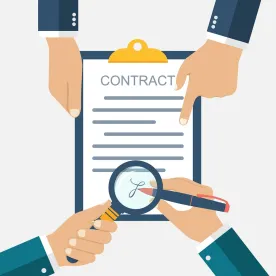Everybody does it. We may say that we only use the “customer’s paper” when contracting, but we know that is often not the case when entering into licenses for commercially available, off-the-shelf (COTS) software products. Maybe if the licensed software is a strategic product or the customer has significant leverage, we are able to work from the customer’s paper, but for ordinary course software licensing, it is common to use the vendor’s paper.
So what then? Using the vendor’s paper does not mean that the contract shouldn’t be reviewed and negotiated to ensure that key issues are addressed. Set forth below is the first part of a quick checklist of issues customers should be mindful of in any software licensing agreement. Today’s items focus on issues that are more business or operational in nature, while the forthcoming post with Part 2 of the checklist will include more traditional legal issues.
-
License Type: How is the software licensed? For how long (perpetual, term, subscription)? And on what terms (named or concurrent user, enterprise, value unit, processor)? Be sure to think about the impact of robots on license usage and entitlement counts for user-based licenses.
-
Use Within the Enterprise and by Third Parties: Who can use the software within enterprise? The signing party only? Affiliates (existing and new)? Joint ventures? What, if any, third parties (e.g., independent contractors, subcontractors, outsourcing providers) are entitled to access and use the software through the license? What additional limits or restrictions are placed on such third parties’ use? Does a separate agreement or form of third party use need to be executed? If so, does the form alter the liability and other rights in the underlying agreements?
-
Divestitures and Acquisitions: What happens to the software licenses if there is a divestiture? Are you able to split the software entitlements between the divesting and divested entities? Can the software be used during a transitional period by the divesting entity to provide services to the divested entity? The transitional period should align with the term of a traditional transition services agreement if possible. What if there is an acquisition? Can the acquiring company leverage the entitlements on behalf of the acquired entity as well as its broader enterprise?
-
Nonproduction Use: Do the license grant and use restrictions allow the company to utilize the software in nonproduction environments, e.g., testing, backup, archive, and disaster recovery (hot, warm, and cold sites)? Is nonproduction use specifically excluded from counting against the software entitlements?
-
Right to Relocate or Change Users: Are you permitted to change or relocate any of the locations, processors, or other assets or equipment on which the software is installed? Are there any notice requirements? If the software is licensed on a user or seat basis, are you able to change users or transfer licenses to account for employees that leave or shift roles and responsibilities?
-
Use Outside the United States: Are there any explicit geographical limitations on the license grant? Are there any indirect limitations on geography included in the definition of authorized users, the restrictions on use, or elsewhere? Consider whether access from an offshore center is considered use outside of the United States that needs to be addressed. In addition, are any of the vendor’s commitments under the agreement limited in geographical scope—compliance with laws, noninfringement, etc.?
-
Obligation to Support: Is the vendor obligated to continue supporting the software for a specified duration? Is this obligation for the current release as well as past releases? Does that timeline align with your business needs? Consider whether there are significant startup costs or other hurdles to transitioning to a new provider in light of the vendor’s continued support commitments, if any.
-
Rights to Successor Products: Does the agreement grant you any rights to receive the vendor’s future product offerings? If so, are your rights limited to updates and upgrades at a version level or do they include new releases of the software? What if the vendor releases a product with similar functionality under a new name?
-
Payments: Are fees payable in advance or in arrears? When are they due (upon delivery, installation, first use in production?) Do the payment terms align with your company’s requirements? Are invoiced amounts that are disputed in good faith excluded from the typical payment terms? For support or term license fees paid in advance, are the fees refundable? Consider a possible prorated refund of prepaid, unused amounts upon early termination.
-
Escalators for Renewal Terms: Is pricing for any renewal terms fixed under the agreement? If not, are there limits on the amount by which the vendor can increase fees for renewal terms? Escalators for renewal terms are particularly concerning in combination with short initial terms and/or auto-renewal provisions. If the vendor can increase fees for renewals, the company should be entitled to notice of such planned increases in advance of the timeframe in which the company must provide notice of nonrenewal.




 />i
/>i

